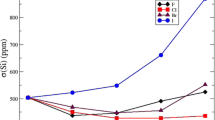Abstract
Nuclei of hydrogen atoms located over a carbon-carbon double bond in the presence of a strong magnetic field experience a perturbed magnetic field caused primarily by the magnetic anisotropy of the π bond. However, the commonly used theoretical model for predicting the shielding effect of an alkene double bond on hydrogen nuclei is sometimes inconsistent with the observed proton NMR chemical shifts in structures that have covalently bonded hydrogens located over a carbon-carbon double bond. We have used the ab initio gauge including atomic orbital (GIAO) method to calculate isotropic shielding values and to determine the proton NMR shielding increments for a simple model system: methane held at various positions over ethene. These shielding increments calculated for one proton of methane have been mapped as a function of their position in Cartesian coordinates relative to the center of ethene. A mathematical function has been fit to this three-dimensional shielding increment surface at each of four distances from the face of the ethene molecule. Additionally, a single mathematical equation has been developed for predicting the shielding caused by the carbon-carbon double bond in ethene. In contrast to the traditionally employed shielding model, our results predict deshielding for protons within 3 Å above the center of a carbon-carbon double bond, consistent with experimental observations in several molecular systems. The NMR shielding increments predicted by this equation are compared to observed shielding increments in some test alkenes.
Similar content being viewed by others
REFERENCES
Pauling, L. J. Chem. Phys. 1936, 4, 673.
Pople, J. A. J. Chem. Phys. 1956, 24, 1111.
McConnell, H. M. J. Chem. Phys. 1957, 27, 226.
For example, Silverstein, R. M.; Bassler, G. C.; Morrill, T. Spectrophotometric Identification of Organic Compounds, 5th ed.; Wiley: New York, 1991, pp. 174–175.
Johnson, C. E., Jr.; Bovey, F. A. J. Chem. Phys. 1958, 29, 1012.
Schneider, H.-J.; Rüdinger, V.; Cuber, U. J. Org. Chem. 1985, 60, 996.
Martin, N. H.; Allen, N. W., III; Moore K. D.; Vo, L. J. Mol. Struct.: (THEOCHEM) 1998, 454, 161–166.
Martin, N. H.; Allen, N. W. III; Minga, E. K.; Ingrassia, S. T.; Brown, J. D. J. Am. Chem. Soc. 1998, 120, 11510–11511.
Spartan version 5.0, Wavefunction, Inc., 18401 Von Karman Ave, #370, Irvine, CA, 1997.
Hehre, W. J.; Radom, L.; Schleyer P. v. R.; Pople, J. A. Ab Initio Molecular Orbital Theory; Wiley: New York, 1986.
Frisch, M. J.; Trucks, G. W.; Schlegel, H. B.; Gill, P. M. W.; Johnson, B. G.; Robb, M. A.; Cheeseman, J. R.; Keith, T.; Petersson, G. A.; Montgomery, J. A.; Raghavachari, K.; Al-Laham, M. A.; Zakrzewski, V. G.; Ortiz, J. V.; Foresman, J. B.; Cioslowski, J.; Stefanov, B. B.; Nanayakkara, A.; Challacombe, M.; Peng, C. Y.; Ayala, P. Y.; Chen, W.; Wong, M. W.; Andres, J. L.; Replogle, E. S.; Gomperts, R.; Martin, R. L.; Fox, D. J.; Binkley, J. S.; Defrees, D. J.; Baker, J.; Stewart, J. P.; Head-Gordon, M.; Gonzalez, C.; Pople, J. A. Gaussian 94, Revision E.2, Gaussian, Inc., Pittsburgh PA, 1995.
Ditchfield, R. Mol. Phys., 1974, 27, 789.
Chesnut, D. B.; Foley, C. K. Chem. Phys. Lett., 1985, 118, 316.
Wolinski, K.; Hinton, J. F.; Pulay, P. J. Am. Chem. Soc. 1990, 112, 8251.
TableCurve3D, v1.0, AISN Software, San Rafael, CA, 1993.
MSExcel97, Microsoft Corporation, Redmond, WA, 1997.
Martin, N. H., unpublished results.
Gunther, H. NMR Spectroscopy: Basic Principles, Concepts, and Applications in Chemistry, 2nd ed.; Wiley: Chichester, 1995, pp. 78–84.
Pauling, L. Nature of the Chemical Bond, 3rd ed.; Cornell University Press; Ithaca, 1960, pp. 260–261.
Warner, P. M.; Peacock, S. J. Comp. Chem. 1982, 3, 417.
Kim, J.-S. Bull. Korean Chem. Soc. 1997, 18, 488.
Author information
Authors and Affiliations
Corresponding author
Rights and permissions
About this article
Cite this article
Martin, N.H., Allen, N.W., Minga, E.K. et al. An Empirical Proton NMR Shielding Equation for Alkenes Based on Ab Initio Calculations. Structural Chemistry 9, 403–410 (1998). https://doi.org/10.1023/A:1022463914156
Issue Date:
DOI: https://doi.org/10.1023/A:1022463914156




